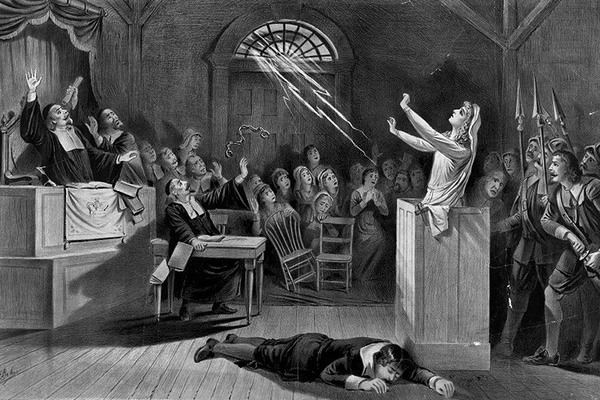What Happened the Last Time the Earth Went Through Climate Change Was Horrifying

Between the thirteenth and nineteenth centuries, as many as one million individuals in Europe were executed for the crime of witchcraft. The majority of the trials and executions took place during the sixteenth and seventeenth centuries. During this period, the speed and volume of executions were astonishing: in one German town, as many as 400 people were killed in a single day. The trials were ubiquitous: conducted by both ecclesiastical and secular courts; by both Catholics and Protestants. The victims were primarily women, primarily poor and disproportionately widows. The persecutions took place throughout Europe, starting and ending earlier in southwest Europe than in the northern and eastern areas, and spread even across the Atlantic Ocean to Salem, Massachusetts. …
This paper explores the possibility that the witchcraft trials are a large-scale example of violence and scapegoating prompted by a deterioration in economic conditions. In this case, the downturn was brought on by a decrease in temperature and resulting food shortages. The most active period of the witchcraft trials coincides with a period of lower than average temperature known to climatologists as the “little ice age.” The colder temperatures increased the frequency of crop failure, and colder seas prevented cod and other fish from migrating as far north, eliminating this vital food source for some northern areas of Europe.
-- From “Witchcraft, Weather and Economic Growth in Renaissance Europe” by Emily Oster
Emily Oster is an associate professor of Economics at Brown University, who writes extensively on a wide variety of public health issues. However, her first published article, “Witchcraft, Weather and Economic Growth in Renaissance Europe” (Journal of Economic Perspectives, Winter 2004), explores the correlation between the Little Ice Age (1500s to 1800s) in early modern Europe and the outbreak of a witch-hunting craze that resulted in the persecution of thousands of victims across Europe. Arguing that the drop in temperatures contributed to significant economic problems and mass human suffering, she contends that putative witches may have served as useful scapegoats. In his 2010 book, A Cultural History of Climate, Wolfgang Behringer calls witchcraft, “the crime of the Little Ice Age.”
Below, Emily Oster answers some questions about her work for the History News Network.
David L. O’Connor: Your paper contends that the sharp increase in witch trials in early modern Europe was tied to the economic problems that were brought on by the Little Ice Age. How did you explain the correlation in the paper?
Emily Oster: A downside of this paper—I think—is that it really doesn't get much into mechanisms. The fundamental approach of the paper is to just look at the data. So what I can show is that in periods in which the temperatures were colder there were also a lot of witch trials. The causality is bolstered by the inclusion of place-and-time fixed effects. So, fundamentally, what this says is that within a location, in colder years there are more trials. But it doesn't do much more than speculate about why.
Your paper has a graph illustrating the inverse relationship between temperature and witch trials. But the chart also shows that some spikes in the number of trials coincide with religious conflicts like the Schmalkalden Wars, the French wars of religion, and the Thirty Years’ War. How did you control for these factors in your analysis?
Factors which influence multiple places within the same time are addressed by fixed effects for years. Basically, the data allows for some time periods to have more trials than others for reasons other than temperature. And ultimately the paper doesn't seek to explain all the variation, just some of it.
How does your work on the Little Ice Age inform your views on current economic, social and cultural issues related to climate change?
I think this paper—and others, more contemporary, about related topics—do illustrate that in times of extreme weather there can be increases in conflict. This is presumably an increased risk as climate change hastens.
You were a graduate student in Harvard’s Economics Department when you wrote “Witchcraft, Weather and Economic Growth in Renaissance Europe.” Why did an aspiring young economist turn her attention to witches in early modern Europe?
I actually wrote this paper - at least the first draft - as a final-year undergraduate in a (history) seminar class on witchcraft. It was a wonderful class and I was really inspired by the idea that data could be brought to bear on this question.
The paper’s bibliography is filled with references to works by historians, psychologists, sociologists, and anthropologists, but no economists. Did you meet any resistance to this project in your department?
This perhaps continues the comment above. When I decided to go graduate school in economics I had been working on this paper and a number of the people I spoke to in the economics department were extremely enthusiastic about it. I did not meet much resistance. I think at that point in my career they were just excited that I was publishing something!
Which historians had the biggest impact on your work and why?
I think the work by [Wolfgang] Behringer, which is the closest to this in substance, had a large influence.
Since
publishing “Witchcraft, Weather and Economic Growth in Renaissance
Europe” your research has taken you a long way from early modern
European history. You’ve written on a variety of public health
issues, including life expectancy, HIV in Sub-Saharan Africa, medical
testing and many others. Is there any connection between your
work on public health issues and your work on witch trials?
Other than the fact that it is not traditional economics, I don't really think so!
Is
there any chance that you’ll return to historical topics any time
soon?
I
have no particular plans, but I guess you never know!